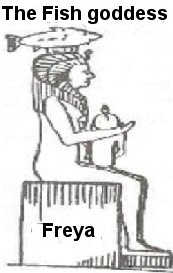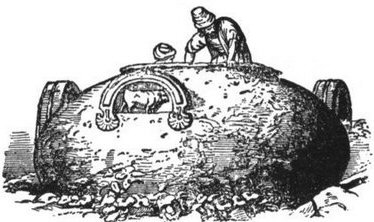Each Friday,
many Catholics abstain from meat--substituting fish in its
place--supposedly in remembrance of the Friday crucifixion.
Roman Catholics in the United States are no longer required by
their church to abstain from meat on Fridays (as formerly)--except
during Lent--nevertheless many still follow the custom of fish on
Friday.
Certainly the
Scriptures never associate fish with Friday. On the other
hand, the word "Friday" comes from the name of "Freya", who was regarded as
the goddess of peace, joy, and FERTILITY, the symbol of her
fertility being the FISH. From very early times the fish was
a symbol of fertility among the Chinese, Assyrians, Phoenicians,
the Babylonians, and others. The word "fish" comes from dag which
implies increase or fertility 12 and with good reason. A
single cod fish annually spawns upwards of 9,000,000 eggs; the
flounder 1,000,000; the sturgeon 700,000; the perch 400,000; the
mackeral 500,000; the herring 10,000, etc.
The fish was
regarded as sacred to Ashtoreth, the name under which the
Israelites Worshiped the SUN
Worship goddess. In ancient Egypt, Isis was
sometimes represented with a fish on her head, as seen in the
accompanying illustration. Considering that Friday was named
after the goddess of sexual fertility, Friday being her sacred
day, and the fish her symbol, it seems like more than a mere
coincidence that Catholics have been taught that Friday is a day
of abstinence from meat, a day to eat fish! From where,
then, did Easter observance come? Did Peter or Paul ever
conduct an Easter SUNrise service? The answers are,
of course, obvious.
Like the word "
Easter",
many of our customs at this season had their beginnings among
non-Christian religions. Easter eggs, for example, are
colored, hid, hunted, and eaten---a custom done innocently
(ignorantly) today and often linked with a time of fun and frolic
for children. But this custom did not originate in
Christianity. The egg was, however, a sacred symbol among
the Babylonians who believed an old fable about an egg of wondrous
size which fell from heaven into the Euphrates River. From
this marvelous egg - according to the ancient myth - the goddess
Astarte (
Easter) was hatched. The egg came to
symbolize the goddess
Easter.
The ancient
Druids bore an egg as the sacred emblem of their idolatrous
order. The procession of Ceres in Rome was preceded by an
egg. In the mysteries of Bacchus an egg was
consecrated. China used dyed or colored eggs in sacred
festivals. In Japan, an ancient custom was to make the
sacred egg a brazen color. In northern Europe, in SUN Worship times, eggs were
colored and used as symbols of the goddess of spring. The
illustration given below shows two ways the SUN Worshipers
represented their sacred eggs. On the left is the Egg of
Heliopolis; on the right, the Typhon's Egg. Among the
Egyptians, the egg was associated with the SUN-the
"golden egg." Their dyed eggs were used as sacred
offerings at the Easter season.
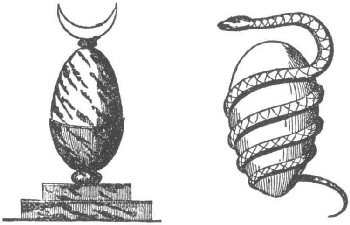
Says The Encyclopedia Britannica, "The egg as a
symbol of fertility and of renewed life goes back to the ancient
Egyptians and Persians, who had also the custom of coloring and
eating eggs during their spring festival. How, then, did
this custom come to be associated with Christianity?
Apparently some sought to Christianize the egg by suggesting that
as the chick comes out of the egg, so Christ came out of the
tomb. Pope Paul V (1605-1621) even appointed a prayer in
this connection: "Bless, O Lord, we beseech thee, this thy
creature of eggs, that it may become wholesome sustenance unto thy
servants, eating it in remembrance of our Lord Jesus Christ.
The following quotations from The Catholic
Encyclopedia are significant. "Because the use of eggs was
forbidden during Lent, they were brought to the table of
Easter
Day, colored red to symbolize the
Easter joy...The custom
may have its origin in
paganism, for a great many,,
pagan
customs celebrating the return of spring, gravitated to
Easter"!
Such was the case with a custom that was popular in Europe.
"The Easter Fire is lit on the top of mountains from new fire,
drawn from wood by friction; this is a custom of
SUN Worship origin in vogue
all over Europe, signifying the victory of spring over
winter. The bishops issued severe edicts against the
sacrilegious
Easter fires, but did not succeed in
abolishing them everywhere." So what happened? Notice
this carefully! "The Church adopted the observance into the
Easter ceremonies, referring it to the fiery column in the
desert and to the resurrection of Christ"! Were
SUN Worship customs mixed into
the Roman church and given the appearance of Christianity?
It is not necessary to take my word for it, in numerous places The
Catholic Encyclopedia comes right out and says so. Finally,
one more quote concerns the
Easter Rabbit : "The rabbit is
a
pagan symbol and has
always been an emblem of fertility."
"Like the
Easter egg, the
Easter
hare", says the Encyclopedia Britannica "came to Christianity from
antiquity. The hare is associated with the moon in the
legends of ancient Egypt and other peoples...Through the fact that
the Egyptian word for hare, um, means also 'open' and 'period',
the hare came to be associated with the idea of periodicity, both
lunar and human, and with the beginning of new life in both the
young man and young woman, and so a symbol of fertility and of the
renewal of life. As such, the hare became linked with
Easter...eggs."
Thus both the
Easter rabbit and
Easter eggs were
symbols of sexual significance, symbols of fertility.
At the
Easter season it is not uncommon
for Christians to attend
SUNrise services. It is
assumed that such honor Christ because he rose from the dead on
Easter
SUNday morning just as the
SUN was coming up.
But the resurrection did not actually occur at
SUNrise,
for it was yet DARK when Mary Magdalene came to the tomb and it
was already, empty! On the other hand, there was a type of
SUNrise
service that was a part of ancient
SUN Worship. We do not
mean to imply, of course, that Christian people today
Worship the SUN in their
Easter
SUNrise services. Nor do we say that those who bow
before the monstrance
SUN-image
with its round,
SUN shaped host are Worshiping
the SUN. But such practices, being without
scriptural example, do indicate that
mixtures have been
made.
In the time of Ezekiel, even people who had
known the true God, fell into
SUN Worship and made it a
part of their Worship. "and he brought me into the inner
court of the Lord's house, and, behold, at the door of the temple
of the Lord, between the porch and the altar, were about five and
twenty men, with their backs toward the temple of the Lord, and
their faces toward the
EAST; and they Worshiped the
SUN
toward the EAST" (Ezekiel 8:16). The fact that they
Worshiped the SUN toward the
east shows it was a SUNrise service. The next
verse says: "...and, lo, they put the branch to their nose."
Fausset says this "alludes to the idolatrous usage of holding up a
branch of tamarisk to the nose at daybreak whilst they sang hymns
to the rising
SUN."
It was also to the
east that the
prophets of Baal looked in the days of Elijah"
Baal was the SUN-god,
and so god of fire. When Elijah challenged the prophets of
Baal with the words, "The God that answers by FIRE, let him be
God", he was meeting Baal Worship on its own grounds. What
time of day was it when these prophets of Baal started calling on
him? It was as Baal--the
SUN--made his first
appearance over the
eastern horizon. It was at
"morning" (1 Kings 18:26), that is, at dawn.
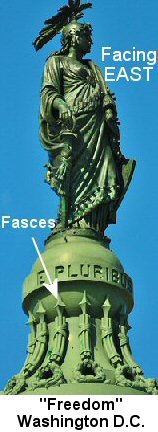
Rites connected with the dawning
SUN--in one form or another
have been known among
many
ancient nations. The Sphinx in Egypt was
located
so as to face the east.
From Mount Fuji-yama, Japan, prayers are made to the rising
SUN. "The pilgrims pray
to their rising
SUN while
climbing the mountain sides...sometimes one may see several
hundreds of Shinto pilgrims in their white robes turning out from
their shelters, and joining their chants to the rising
SUN." The
SUN Worship Mithrists of Rome
met together at dawn in honor of the
SUN-god. And in modern Rome, on top of the
Capital of Washington D.C. the statue
"Freedom" faces EAST to the rising SUN. (picture to the right)
The goddess of spring, from whose name our word
"
Easter" comes, was associated with the
SUN rising in the
east--even
as the very word "
East-er" would seem to imply. Thus
the dawn of the
SUN in
the
east,
the name
Easter, and the spring season are all connected.
According to the old legends, after Tammuz was
slain, he descended into the underworld. But through the weeping
of his "mother", Ishtar (
Easter), he was mystically revived
in spring. "The resurrection of Tammuz through Ishtar's
grief was dramatically represented annually in order to insure the
success of the crops and the fertility of the people. Each
year men and women had to grieve with Ishtar over the death of
Tammuz and celebrate the god's return in order to win anew her
favor and her benefits!. When the new vegetation began to
come forth, those ancient people believed their "savior" had come
from the underworld, had ended winter, and caused spring to begin.
Even the Israelites adopted the doctrines and rites of the
annual
SUN Worship spring
festival, for Ezekiel speaks of "women weeping for Tammuz"
(Ezekiel 8 :14).
As Christians we believe that Jesus Christ rose
from the dead in reality-not merely in nature or the new
vegetation of spring. Because his resurrection was in the
spring of the year, it was not too difficult for the church of the
fourth century (now having departed from the original faith in a
number of ways) to merge the
SUN
Worship spring festival into Christianity. In
speaking of this merger, the Encyclopedia Britannica says, "
Christianity...incorporated
in its celebration of the great Christian feast day many of the
heathen rites and customs of the spring festival"!
Legend has it that Tammuz was killed by a wild
boar when he was forty years old. Hislop points out that forty
days--a day for each year Tammuz had lived on earth--were set
aside to "weep for Tammuz." In olden times these forty days
were observed with weeping, fasting, and self-chastisement--gain
anew his favor--so he would come forth from the underworld and
cause spring to begin. This observance was not only known at
Babylon, but also among the Phoenicians, Egyptians, Mexicans, and,
for a time, even among the Israelites. "Among the
SUN Worshipers", says Hislop,
"this Lent seems to have been an indispensable preliminary to the
great annual festival in commemoration of the death and
resurrection of Tammuz.
Having adopted other beliefs about the spring
festival into the church, it was only another step in the
development to also adopt the old "fast" that proceeded the
festival. The Catholic Encyclopedia very honestly points out
that "writers in the fourth century were prone to describe many
practices (the Lenten fast of forty days) as of Apostolic
institution which certainly had no claim to be so regarded."
It was not until the sixth century that the pope officially
ordered the observance of Lent, calling it a "sacred fast" during
which people were to abstain from meat and a few other foods.
Catholic scholars know and recognize that there
are customs within their church which were borrowed from
SUN Worship. But they
reason that many things, though originally
SUN Worship, can be
Christianized. If some
SUN
Worship tribe observed
forty days in honor of a
SUN
Worship god, why should we
not do the same, only in honor of Christ? Though
SUN Worshipers Worshiped
the SUN toward the EAST, could we not
have
SUNrise services to
honor the resurrection of Christ, even though this was not the
time of day he arose?
Even
though the egg was used by
SUN
Worshipers, can't we continue its use and pretend it
symbolizes the large rock that was in front of the tomb? In
other words, why not adopt all kinds of popular customs, only
instead of using them to honor
SUN
Worship gods, as the heathen did, use them to honor
Christ? It all sounds very logical, yet a much safer
guideline is found in the Bible itself: "Take heed...that thou
inquire not after their gods (
SUN
Worship gods), saying: How did these nations serve their
gods? even so will I do likewise. Thou shalt not do so unto
the Lord thy God...What thing soever I command you, observe to do
it; thou shalt not add thereto." Deut. 12:30-32
“Signs and symbols rule the SUN Worship world, not
words nor laws.”
www.granddesignexposed.com
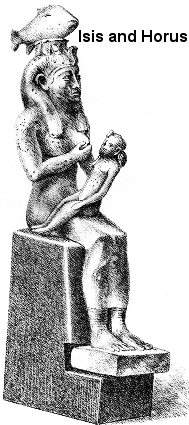 Venus ruled the first hour of Friday
and thus was called dies Veneris. And-to make the
significance complete-the fish was also regarded as being sacred
to her. The accompanying illustration as seen in Ancient SUN Worship and Modern
Christian Symbolism shows the goddess Venus with her symbol, the
fish.
Venus ruled the first hour of Friday
and thus was called dies Veneris. And-to make the
significance complete-the fish was also regarded as being sacred
to her. The accompanying illustration as seen in Ancient SUN Worship and Modern
Christian Symbolism shows the goddess Venus with her symbol, the
fish.